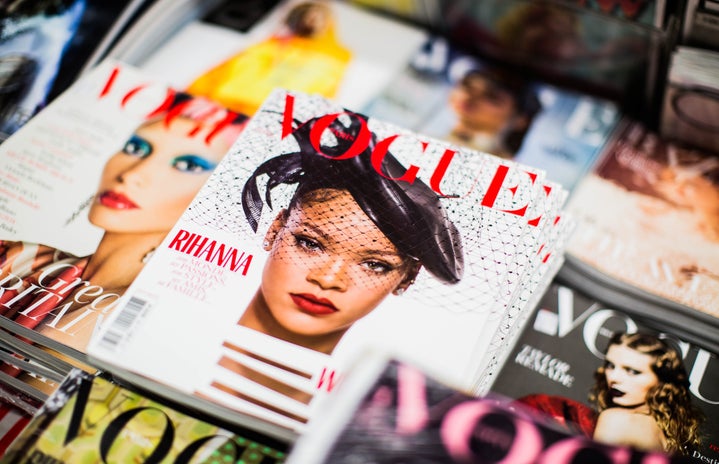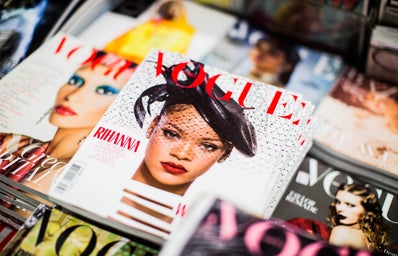It’s unclear who is to blame for Vogue’s repetitive and non creative covers with celebrities, influencers, and limited photographers as top contenders but…
One thing is for sure: Vogue has lost its spark.
For the past few years, the covers of fashion’s most illustrious magazine have stuck to drab shoots that leave the impression that its editor-in-chief, Anna Wintour, is losing her hold on the room reserved for the magazine in the industry supposedly defined by it.
What exactly is going wrong with Vogue?
Vogue’s reluctance to place their celebrities anywhere far away from a backdrop with an expression on their face as the star of the show is the tip of the iceberg. This goes against everything that the magazine stands for: innovation, boldness, and vitality. Shalom Harlow, one of the supermodels that made up the late 1990s scene, slyly said in a recent “Life in Looks” video on Vogue’s YouTube channel that “Just being able to point an iPhone and take a selfie doesn’t make you a supermodel. Sorry, not sorry”. If there really is a difference between supermodels and Instagram models, then Vogue’s cover stars should do more than just pose against a wall.
Over the past few years, there have been too many lackluster studio shoots for covers and other fashion stories. As a result, since 2020, there have been, on average, four issues a year that a celebrity is standing in front of either a gray, beige, or brown backdrop. It’s uninspiring and disappointing.
Moreover, the value that many of us place on celebrities getting asked to be the face of the magazine is not reciprocated by those asking, as seen in recycling the same faces every few months. For example, Bella Hadid was on the cover of Vogue twice in less than one year. She joined other young models for the September 2021 issue and, most recently, was the solo cover for April 2022– only eight months since her last cover. In fact, the 2022 lineup had six stars that previously graced the cover, diminishing the novelty of being selected.
Vogue’s decline in prominence is its heavy reliance on a few photographers to capture their year-long spread. Annie Leibovitz and Mario Testino have dominated the US Vogue cover shoot for decades, making their many photos repetitive and predictable. Since 2000, Testino has captured 75 covers and Leibovitz 70 covers. Those numbers add up to show that over half of the 274 issues published for the last two decades were pushed onto two single photographers. Vogue is comforted by repeatedly turning to the same photographers because the brand trusts that its product will perform like it always has.
However, when will Wintour realize that styles of profitable photographers from the 2010s don’t fit into our time? For example, Leibovitz produced a masterful photo story of model Coco Rocha for the Vogue December 2008 issue that fashion lovers long to see replicated. However, what Leibovitz does today is starkly contrasted with her past creations. Her most recent covers of Rihanna in May 2022 and Jennifer Lopez in December 2022 are deconstructed and don’t match what our maximalist culture is craving.
How have these problems affected Vogue?
These worrying signs are evident in Vogue’s changing format. Since 1973, Vogue has been running on a 12-month publishing cycle but starting in 2020, the June and July issues combined into one. This change has continued, and the most current alteration to the schedule is replacing the January 2023 issue with a single Winter issue.
It’s becoming increasingly clear that Vogue no longer stands as the rulebook for what’s in and out. Today’s culture cares much less about fitting in and much more about standing out. Vogue is only giving us images, but what we need are visions. Visions of who we want to be, dream to be and could be. This mindset once dictated what Vogue produced.
What does Vogue need to do to survive?
When Wintour first became editor-in-chief for US Vogue in 1988, her first issue took a significant shift in the format not taken by previous editors. She used a new photographer who became synonymous with the supermodel generation; she accentuated a model’s personality instead of just their looks; and she celebrated the celebrity and put them on her covers.
Vogue has been a focal point in fashion culture for decades, long before social media became the driving force for trends. We have access to all the inspiration we could desire in the palms of our hands, but we need the element of fashion that once transcended magazine pages, flowed from runways, and entered the streets of cities worldwide.
Wintour is one of the only change-makers capable of welcoming the return of fashion’s best quality: culture.
There’s hope that she will make waves again after she hosted the “Vogue World” event during New York’s most recent Fashion Week. It was a fashion show that embraced a refreshing yet familiar sense of life. The live energy pumped to the rhythm of the disco beat and radiated through the viewers on the street. Models, performers, athletes, and many more walked the streets of the Meatpacking district in that season’s newest collections, and wait for this; they were smiling.


